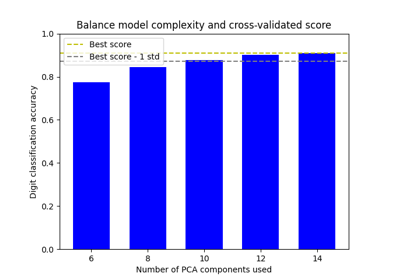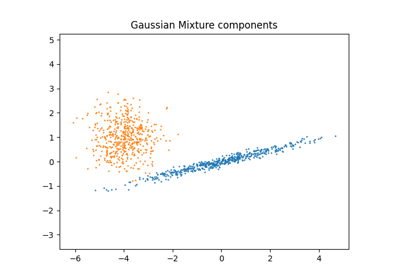Note
Go to the end to download the full example code. or to run this example in your browser via Binder
网格搜索与交叉验证的自定义重拟合策略#
本示例展示了如何通过交叉验证优化分类器,
这是使用 GridSearchCV 对象
在仅包含一半可用标记数据的开发集上完成的。
然后在专门的评估集上测量所选超参数和训练模型的性能, 该评估集在模型选择步骤中未被使用。
有关模型选择工具的更多详细信息,请参见 交叉验证:评估估计器性能 和 调整估计器的超参数 部分。
The dataset#
我们将使用 digits 数据集。目标是对手写数字图像进行分类。
为了便于理解,我们将问题转化为二分类问题:目标是识别一个数字是否为 8 。
from sklearn import datasets
digits = datasets.load_digits()
为了在图像上训练分类器,我们需要将它们展平为向量。
每个8x8像素的图像需要转换为64像素的向量。
因此,我们将得到一个形状为 (n_images, n_pixels) 的最终数据数组。
n_samples = len(digits.images)
X = digits.images.reshape((n_samples, -1))
y = digits.target == 8
print(
f"The number of images is {X.shape[0]} and each image contains {X.shape[1]} pixels"
)
The number of images is 1797 and each image contains 64 pixels
正如介绍中所述,数据将被分成大小相等的训练集和测试集。
from sklearn.model_selection import train_test_split
X_train, X_test, y_train, y_test = train_test_split(X, y, test_size=0.5, random_state=0)
定义我们的网格搜索策略#
我们将通过在训练集的折叠上搜索最佳超参数来选择分类器。为此,我们需要定义选择最佳候选者的评分标准。
scores = ["precision", "recall"]
我们还可以定义一个函数传递给 GridSearchCV 实例的 refit 参数。该函数将实现自定义策略,从 GridSearchCV 的 cv_results_ 属性中选择最佳候选者。一旦候选者被选中,它将自动由 GridSearchCV 实例重新拟合。
在这里,策略是筛选出在精度和召回率方面表现最好的模型。从选定的模型中,我们最终选择预测速度最快的模型。请注意,这些自定义选择是完全任意的。
import pandas as pd
def print_dataframe(filtered_cv_results):
"""过滤后的数据框美化打印"""
for mean_precision, std_precision, mean_recall, std_recall, params in zip(
filtered_cv_results["mean_test_precision"],
filtered_cv_results["std_test_precision"],
filtered_cv_results["mean_test_recall"],
filtered_cv_results["std_test_recall"],
filtered_cv_results["params"],
):
print(
f"precision: {mean_precision:0.3f} (±{std_precision:0.03f}),"
f" recall: {mean_recall:0.3f} (±{std_recall:0.03f}),"
f" for {params}"
)
print()
def refit_strategy(cv_results):
"""定义选择最佳估计器的策略。
这里定义的策略是过滤掉所有低于0.98精度阈值的结果,按召回率对剩余结果进行排序,并保留召回率在最佳值一个标准差范围内的所有模型。一旦选定这些模型,我们可以选择预测最快的模型。
Parameters
----------
cv_results : dict of numpy (masked) ndarrays
`GridSearchCV` 返回的交叉验证结果。
返回
-------
best_index : int
最佳估计器在 `cv_results` 中的索引。
"""
# 打印不同评分的网格搜索信息
precision_threshold = 0.98
cv_results_ = pd.DataFrame(cv_results)
print("All grid-search results:")
print_dataframe(cv_results_)
# 过滤掉所有低于阈值的结果
high_precision_cv_results = cv_results_[
cv_results_["mean_test_precision"] > precision_threshold
]
print(f"Models with a precision higher than {precision_threshold}:")
print_dataframe(high_precision_cv_results)
high_precision_cv_results = high_precision_cv_results[
[
"mean_score_time",
"mean_test_recall",
"std_test_recall",
"mean_test_precision",
"std_test_precision",
"rank_test_recall",
"rank_test_precision",
"params",
]
]
# 选择召回率表现最好的模型(在最佳模型的1个标准差范围内)
best_recall_std = high_precision_cv_results["mean_test_recall"].std()
best_recall = high_precision_cv_results["mean_test_recall"].max()
best_recall_threshold = best_recall - best_recall_std
high_recall_cv_results = high_precision_cv_results[
high_precision_cv_results["mean_test_recall"] > best_recall_threshold
]
print(
"Out of the previously selected high precision models, we keep all the\n"
"the models within one standard deviation of the highest recall model:"
)
print_dataframe(high_recall_cv_results)
# 从最佳候选者中选择最快的模型进行预测
fastest_top_recall_high_precision_index = high_recall_cv_results[
"mean_score_time"
].idxmin()
print(
"\nThe selected final model is the fastest to predict out of the previously\n"
"selected subset of best models based on precision and recall.\n"
"Its scoring time is:\n\n"
f"{high_recall_cv_results.loc[fastest_top_recall_high_precision_index]}"
)
return fastest_top_recall_high_precision_index
调整超参数#
一旦我们定义了选择最佳模型的策略,我们就定义超参数的值并创建网格搜索实例:
from sklearn.model_selection import GridSearchCV
from sklearn.svm import SVC
tuned_parameters = [
{"kernel": ["rbf"], "gamma": [1e-3, 1e-4], "C": [1, 10, 100, 1000]},
{"kernel": ["linear"], "C": [1, 10, 100, 1000]},
]
grid_search = GridSearchCV(
SVC(), tuned_parameters, scoring=scores, refit=refit_strategy
)
grid_search.fit(X_train, y_train)
All grid-search results:
precision: 1.000 (±0.000), recall: 0.854 (±0.063), for {'C': 1, 'gamma': 0.001, 'kernel': 'rbf'}
precision: 1.000 (±0.000), recall: 0.257 (±0.061), for {'C': 1, 'gamma': 0.0001, 'kernel': 'rbf'}
precision: 1.000 (±0.000), recall: 0.877 (±0.069), for {'C': 10, 'gamma': 0.001, 'kernel': 'rbf'}
precision: 0.968 (±0.039), recall: 0.780 (±0.083), for {'C': 10, 'gamma': 0.0001, 'kernel': 'rbf'}
precision: 1.000 (±0.000), recall: 0.877 (±0.069), for {'C': 100, 'gamma': 0.001, 'kernel': 'rbf'}
precision: 0.905 (±0.058), recall: 0.889 (±0.074), for {'C': 100, 'gamma': 0.0001, 'kernel': 'rbf'}
precision: 1.000 (±0.000), recall: 0.877 (±0.069), for {'C': 1000, 'gamma': 0.001, 'kernel': 'rbf'}
precision: 0.904 (±0.058), recall: 0.890 (±0.073), for {'C': 1000, 'gamma': 0.0001, 'kernel': 'rbf'}
precision: 0.695 (±0.073), recall: 0.743 (±0.065), for {'C': 1, 'kernel': 'linear'}
precision: 0.643 (±0.066), recall: 0.757 (±0.066), for {'C': 10, 'kernel': 'linear'}
precision: 0.611 (±0.028), recall: 0.744 (±0.044), for {'C': 100, 'kernel': 'linear'}
precision: 0.618 (±0.039), recall: 0.744 (±0.044), for {'C': 1000, 'kernel': 'linear'}
Models with a precision higher than 0.98:
precision: 1.000 (±0.000), recall: 0.854 (±0.063), for {'C': 1, 'gamma': 0.001, 'kernel': 'rbf'}
precision: 1.000 (±0.000), recall: 0.257 (±0.061), for {'C': 1, 'gamma': 0.0001, 'kernel': 'rbf'}
precision: 1.000 (±0.000), recall: 0.877 (±0.069), for {'C': 10, 'gamma': 0.001, 'kernel': 'rbf'}
precision: 1.000 (±0.000), recall: 0.877 (±0.069), for {'C': 100, 'gamma': 0.001, 'kernel': 'rbf'}
precision: 1.000 (±0.000), recall: 0.877 (±0.069), for {'C': 1000, 'gamma': 0.001, 'kernel': 'rbf'}
Out of the previously selected high precision models, we keep all the
the models within one standard deviation of the highest recall model:
precision: 1.000 (±0.000), recall: 0.854 (±0.063), for {'C': 1, 'gamma': 0.001, 'kernel': 'rbf'}
precision: 1.000 (±0.000), recall: 0.877 (±0.069), for {'C': 10, 'gamma': 0.001, 'kernel': 'rbf'}
precision: 1.000 (±0.000), recall: 0.877 (±0.069), for {'C': 100, 'gamma': 0.001, 'kernel': 'rbf'}
precision: 1.000 (±0.000), recall: 0.877 (±0.069), for {'C': 1000, 'gamma': 0.001, 'kernel': 'rbf'}
The selected final model is the fastest to predict out of the previously
selected subset of best models based on precision and recall.
Its scoring time is:
mean_score_time 0.002186
mean_test_recall 0.877206
std_test_recall 0.069196
mean_test_precision 1.0
std_test_precision 0.0
rank_test_recall 3
rank_test_precision 1
params {'C': 1000, 'gamma': 0.001, 'kernel': 'rbf'}
Name: 6, dtype: object
通过我们的自定义策略,网格搜索选择的参数是:
grid_search.best_params_
{'C': 1000, 'gamma': 0.001, 'kernel': 'rbf'}
最后,我们在留出的评估集上评估微调后的模型: grid_search 对象 已自动重新拟合 到完整的训练集,并使用我们自定义的重新拟合策略选择的参数。
我们可以使用分类报告来计算留出集上的标准分类指标:
from sklearn.metrics import classification_report
y_pred = grid_search.predict(X_test)
print(classification_report(y_test, y_pred))
precision recall f1-score support
False 0.99 1.00 0.99 807
True 1.00 0.87 0.93 92
accuracy 0.99 899
macro avg 0.99 0.93 0.96 899
weighted avg 0.99 0.99 0.99 899
问题太简单了:超参数平台过于平坦,输出模型在精度和召回率方面相同,质量上没有差异。
Total running time of the script: (0 minutes 6.010 seconds)
Related examples





